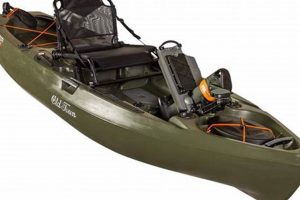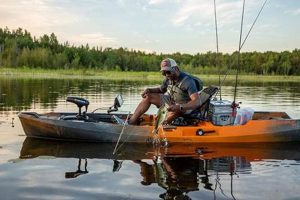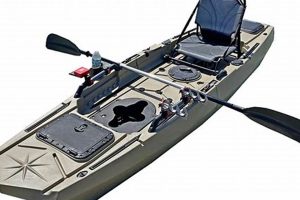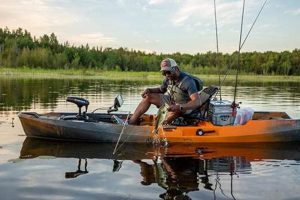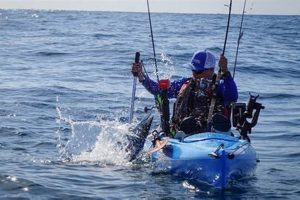Elevated angling platforms offer enhanced visibility and casting range compared to traditional sit-in or sit-on-top kayaks. These platforms are typically wider and more stable, allowing anglers to move around freely and sight fish effectively. They often feature specialized design elements such as non-slip surfaces, integrated rod holders, and ample storage for fishing gear.
The stability and freedom of movement afforded by these specialized watercraft improve casting accuracy and the ability to fight fish effectively. The elevated perspective allows for better spotting of fish and underwater structures. Furthermore, the increased deck space often facilitates hands-free fishing with the aid of accessories like anchor trolleys and power-pole micro anchors. This evolution in kayak design signifies a shift towards maximizing angler efficiency and comfort.
This article will further explore the key features to consider when selecting such a watercraft, including hull design, propulsion systems, and essential accessories. It will also delve into the various fishing techniques that benefit from this style of kayak fishing, along with safety considerations and recommended practices.
Tips for Elevated Kayak Angling
Careful planning and preparation contribute significantly to a successful and enjoyable fishing experience from an elevated platform. The following tips offer guidance for maximizing efficiency and safety.
Tip 1: Prioritize Stability: Wider hulls and carefully distributed weight enhance stability. Practice entering and exiting the kayak in shallow water before venturing into deeper areas.
Tip 2: Select Appropriate Gear: Rod holders, anchor systems, and gear tethers improve organization and prevent equipment loss. Consider a high-quality personal flotation device specifically designed for kayak fishing.
Tip 3: Master Paddle or Pedal Propulsion: Practice maneuvering the kayak efficiently and understand the impact of wind and currents on navigation.
Tip 4: Understand Weight Capacity: Respect the manufacturer’s specified weight limits, including angler weight, gear, and potential catch. Overloading can compromise stability and safety.
Tip 5: Check Weather Conditions: Avoid venturing out in adverse weather, including strong winds, lightning storms, or rough seas. Always inform someone of your fishing plans and expected return time.
Tip 6: Utilize Appropriate Anchoring Techniques: Employing an anchor trolley system or power-pole micro anchor allows for precise positioning and drift control, maximizing fishing effectiveness.
Tip 7: Practice Casting Techniques: The added height and stability offer opportunities for longer casts. Practice refining casting techniques to optimize accuracy and distance.
Adhering to these guidelines will enhance safety and contribute to a more productive and enjoyable fishing experience on elevated angling platforms. Proper preparation and mindful practices allow anglers to focus on the sport and appreciate the unique perspective these platforms provide.
This article concludes with a discussion of responsible angling practices and the importance of conservation efforts.
1. Stability
Stability forms the cornerstone of a successful fishing experience on elevated kayak platforms. A stable platform enables anglers to stand confidently, cast effectively, and react to fish strikes without compromising safety. This core principle influences design choices, material selection, and overall performance.
- Hull Design:
Wider hulls and flattened bottoms generally provide greater initial stability, reducing the likelihood of tipping. Hull design also influences secondary stability the resistance to capsizing after being tilted. A kayak with strong secondary stability recovers more easily from unexpected movements or external forces such as waves or currents.
- Weight Distribution:
Evenly distributing weight within the kayak is critical for maintaining balance. Proper placement of gear and the angler’s body position significantly impact stability. Lowering the center of gravity by positioning heavier items closer to the bottom of the kayak improves overall stability.
- Water Conditions:
Calm, flat water presents fewer stability challenges compared to choppy or fast-moving water. Anglers should be mindful of changing water conditions and adjust their movements accordingly. Understanding the impact of wind and currents on stability is crucial for safe navigation.
- Angler Experience:
Experience plays a significant role in maintaining balance on elevated fishing kayaks. Beginners should practice in calm, shallow water before venturing into more challenging conditions. Developing a sense of balance and understanding the kayak’s responsiveness are essential skills for safe and effective angling.
These factors contribute to the overall stability of elevated fishing kayaks, directly influencing angler safety and fishing effectiveness. Choosing a kayak with appropriate stability characteristics for the intended fishing environment and angler experience is crucial for maximizing enjoyment and success on the water.
2. Maneuverability
Maneuverability is a critical performance characteristic influencing the effectiveness and enjoyment of elevated kayak angling. Efficient navigation through various water conditions, precise positioning for optimal casting angles, and the ability to respond quickly to changing fish behavior all depend on a kayak’s responsiveness and ease of control. The interplay of hull design, propulsion systems, and water conditions significantly impacts maneuverability.
Hull design plays a pivotal role in determining how a kayak responds to paddle strokes or pedal input. Shorter kayaks generally offer greater agility in tight spaces, enabling quick turns and adjustments. Longer kayaks, while potentially faster in open water, may require more effort to turn sharply. The presence of a rudder or skeg system can enhance tracking and directional stability, particularly in windy conditions or strong currents. Propulsion choice also affects maneuverability. Paddle propulsion offers nuanced control and the ability to make subtle adjustments, while pedal drives provide hands-free operation, allowing anglers to focus on fishing. However, pedal drives may limit maneuverability in very shallow water or areas with dense vegetation.
Understanding the relationship between maneuverability and the intended fishing environment is essential. Kayaks designed for navigating narrow creeks and rivers prioritize agility and responsiveness, while those intended for open lakes or coastal areas may emphasize tracking and speed. Consideration of these factors allows anglers to select a kayak that best suits their fishing style and target locations. Effective maneuvering enhances fishing efficiency, allowing anglers to access prime fishing spots, maintain optimal casting positions, and react quickly to fish activity. This control translates directly into increased fishing success and a more fulfilling experience on the water.
3. Fishing Features
Specialized features distinguish fishing kayaks from recreational models, enhancing angler efficiency and overall fishing success. These integrated design elements cater specifically to the needs of anglers, providing practical solutions for gear management, fish handling, and enhanced on-the-water performance. Elevated fishing kayaks often incorporate these features to maximize their utility as dedicated fishing platforms.
Rod holders, strategically positioned throughout the kayak, secure rods while paddling or attending to other tasks, freeing hands for navigation and other essential activities. Tackle storage compartments provide organized storage for lures, hooks, and other essential fishing gear, ensuring quick access and preventing clutter on the deck. Livewells, integrated tanks designed to hold bait or caught fish, maintain bait vitality and preserve the freshness of the catch. These features contribute significantly to a streamlined and productive fishing experience. For example, flush-mounted rod holders minimize line tangling, while recessed tackle trays prevent gear from shifting during movement. The integration of these specialized features directly impacts fishing success by allowing anglers to focus on the task at hand rather than managing equipment.
Understanding the purpose and effective utilization of these features is essential for maximizing the potential of an elevated fishing kayak. Proper rod holder placement facilitates efficient casting and retrieval. Organized tackle storage reduces time spent searching for specific items, allowing anglers to respond quickly to changing fishing conditions. Maintaining a well-organized and functional fishing platform contributes directly to a more productive and enjoyable experience. The strategic incorporation of fishing-specific features into elevated kayak designs reinforces their value as dedicated angling platforms.
4. Propulsion Options
Propulsion systems significantly influence the performance and versatility of elevated fishing kayaks, impacting speed, maneuverability, and overall fishing effectiveness. Understanding the advantages and disadvantages of various propulsion methods allows anglers to select the system best suited to their individual needs and fishing environments.
Traditional paddle propulsion offers a cost-effective and versatile solution, providing nuanced control and maneuverability in tight spaces and shallow water. Paddle kayaks typically require less maintenance and are easier to transport. However, paddling requires physical exertion, potentially limiting fishing time, especially in larger bodies of water or against strong currents. Pedal-powered kayaks, utilizing either propeller or fin drives, offer hands-free operation, allowing anglers to focus on fishing while maintaining position or covering greater distances. This hands-free propulsion enhances casting efficiency and reduces fatigue, particularly during long fishing trips. However, pedal drives often increase the kayak’s weight and complexity, potentially impacting portability and requiring more specialized maintenance.
Motorized kayaks, equipped with electric or gasoline-powered motors, offer the greatest speed and range, enabling anglers to access distant fishing spots quickly and efficiently. Motorized propulsion minimizes physical exertion, allowing for longer fishing trips and facilitating navigation in challenging conditions. However, motorized kayaks introduce additional considerations, including battery life, fuel consumption, noise levels, and environmental regulations. The choice of propulsion system directly impacts fishing effectiveness and the overall experience. Paddle propulsion suits anglers prioritizing maneuverability and simplicity. Pedal drives benefit those seeking hands-free operation and enhanced casting efficiency. Motorized propulsion caters to anglers requiring greater range and speed. Careful consideration of these factors ensures selection of the propulsion system best aligned with individual fishing styles and target environments.
5. Storage Capacity
Ample and well-designed storage is crucial for elevated fishing kayaks, directly impacting organization, efficiency, and overall fishing success. These platforms, designed for stability and freedom of movement, often incorporate specialized storage solutions to accommodate fishing gear, personal items, and potential catches. Efficient storage contributes to a clutter-free deck, maximizing usable space and enhancing angler safety and mobility.
- Tank Wells:
Large, open compartments, often located at the bow or stern, provide versatile storage for larger items like tackle boxes, dry bags, and coolers. Securing these items with bungee cords or straps prevents shifting during movement. Tank wells offer readily accessible storage for frequently used equipment.
- Dry Storage Hatches:
Sealed compartments, often located within the hull, protect sensitive items like electronics, wallets, and keys from water damage. These hatches offer secure storage for essential gear requiring protection from the elements.
- Rod Storage:
Dedicated rod holders, either flush-mounted or adjustable, secure fishing rods while paddling or attending to other tasks. Rod storage systems prevent tangling and protect rods from damage, ensuring they are readily available when needed. Some models integrate horizontal rod storage within the hull for added protection during transport.
- Smaller Compartments and Trays:
Smaller compartments, often located within reach of the angler, provide organized storage for lures, tools, and other frequently accessed items. These designated spaces enhance efficiency by minimizing time spent searching for specific gear. Recessed trays prevent items from sliding or rolling during movement.
Strategic utilization of these storage solutions contributes significantly to a well-organized and efficient fishing experience. A clutter-free deck maximizes casting space and minimizes the risk of tripping or entanglement. Efficient storage promotes a safe and productive fishing environment, allowing anglers to focus on the task at hand. The availability and thoughtful design of storage solutions within elevated fishing kayaks underscore their value as dedicated angling platforms.
6. Weight Capacity
Weight capacity is a critical factor influencing the performance, safety, and longevity of elevated fishing kayaks. Understanding and respecting the manufacturer’s specified weight limit is paramount for maintaining stability, preventing structural damage, and ensuring a safe and enjoyable fishing experience. This limit encompasses the combined weight of the angler, gear, and any potential catch.
- Stability and Performance:
Exceeding the weight capacity compromises stability, increasing the risk of capsizing, especially in challenging conditions like rough water or strong currents. Overloading also negatively impacts performance, reducing maneuverability and responsiveness. A kayak operating within its designated weight range performs optimally, providing a stable and predictable platform for fishing activities.
- Structural Integrity:
Excessive weight strains the kayak’s structure, potentially leading to hull deformation, seam stress, and eventual failure. Respecting the weight limit preserves the kayak’s structural integrity, ensuring its longevity and safe operation. Repeated overloading can weaken the hull, increasing the likelihood of leaks or catastrophic failure.
- Safety Considerations:
Overloading a kayak significantly increases safety risks, particularly in adverse weather conditions or remote locations. A kayak operating beyond its weight limit becomes less responsive and more difficult to control, potentially leading to accidents or injuries. Adhering to the weight limit prioritizes angler safety and responsible use of the equipment.
- Legal and Ethical Implications:
In some regions, exceeding a vessel’s designated weight capacity violates safety regulations and can result in penalties. Furthermore, overloading a kayak demonstrates a disregard for safety recommendations and potentially endangers other water users. Responsible kayak operation includes respecting weight limits and prioritizing safe boating practices.
Careful consideration of weight capacity is essential for selecting an appropriate elevated fishing kayak. Anglers should accurately assess their weight, gear, and potential catch to ensure the chosen kayak meets their specific needs without exceeding its limitations. Prioritizing weight capacity contributes significantly to a safe, enjoyable, and responsible fishing experience. Neglecting this critical factor compromises not only personal safety but also the longevity and performance of the kayak.
Frequently Asked Questions
This section addresses common inquiries regarding elevated fishing kayaks, providing concise and informative responses to facilitate informed decision-making and promote safe and effective use.
Question 1: What are the primary advantages of elevated fishing kayaks compared to traditional sit-on-top or sit-in kayaks?
Elevated platforms offer enhanced visibility for spotting fish and improved casting leverage, increasing angling effectiveness. The ability to stand provides greater freedom of movement and a more comfortable fishing experience, particularly during extended trips.
Question 2: Are elevated fishing kayaks suitable for beginners?
While stability varies between models, some elevated kayaks offer excellent stability suitable for beginners. Practicing in calm, shallow water is recommended before venturing into more challenging conditions. Selecting a wider, more stable model enhances confidence and reduces the learning curve.
Question 3: What factors should be considered when choosing a propulsion system (paddle, pedal, or motor)?
Fishing environment, physical capabilities, and desired fishing style influence propulsion choice. Paddles offer versatility and affordability, pedal drives provide hands-free operation, and motors offer speed and range. Each system presents distinct advantages and disadvantages.
Question 4: How important is weight capacity when selecting an elevated fishing kayak?
Weight capacity is paramount for safety and performance. Exceeding the specified limit compromises stability, maneuverability, and structural integrity. Accurately assessing angler weight, gear, and potential catch ensures appropriate kayak selection.
Question 5: What safety precautions should be taken when using elevated fishing kayaks?
Wearing a personal flotation device, informing someone of fishing plans, checking weather conditions, and carrying essential safety equipment are crucial precautions. Practicing self-rescue techniques and understanding water conditions further enhance safety.
Question 6: What maintenance is required for an elevated fishing kayak?
Regular rinsing with fresh water after each use removes salt and debris, prolonging the kayak’s lifespan. Inspecting hulls, seams, and hardware for damage ensures safe operation. Specific maintenance requirements vary depending on the propulsion system and construction materials.
Understanding these key aspects of elevated fishing kayaks equips anglers with the knowledge necessary to make informed decisions and enjoy a safe and successful fishing experience. Careful consideration of individual needs, fishing environments, and safety precautions enhances on-the-water performance and enjoyment.
This concludes the frequently asked questions section. The following section will offer insights into advanced fishing techniques specific to elevated angling platforms.
Conclusion
Elevated angling platforms represent a significant advancement in kayak fishing technology, offering enhanced stability, visibility, and freedom of movement compared to traditional kayak designs. This article explored key aspects of these specialized watercraft, including hull design, propulsion options, fishing-specific features, storage capacity, and weight capacity considerations. Understanding these elements is crucial for informed selection and optimal utilization of these advanced angling platforms. Proper preparation, adherence to safety guidelines, and mindful practices maximize fishing effectiveness and ensure a safe and enjoyable experience.
As angling technology continues to evolve, elevated fishing kayaks represent a compelling option for anglers seeking to enhance their on-the-water experience. Careful consideration of individual needs, fishing environments, and responsible angling practices will contribute to the continued growth and enjoyment of this dynamic segment of the fishing community. The future of kayak angling continues to evolve, driven by innovation and a dedication to maximizing both angler performance and environmental stewardship.

